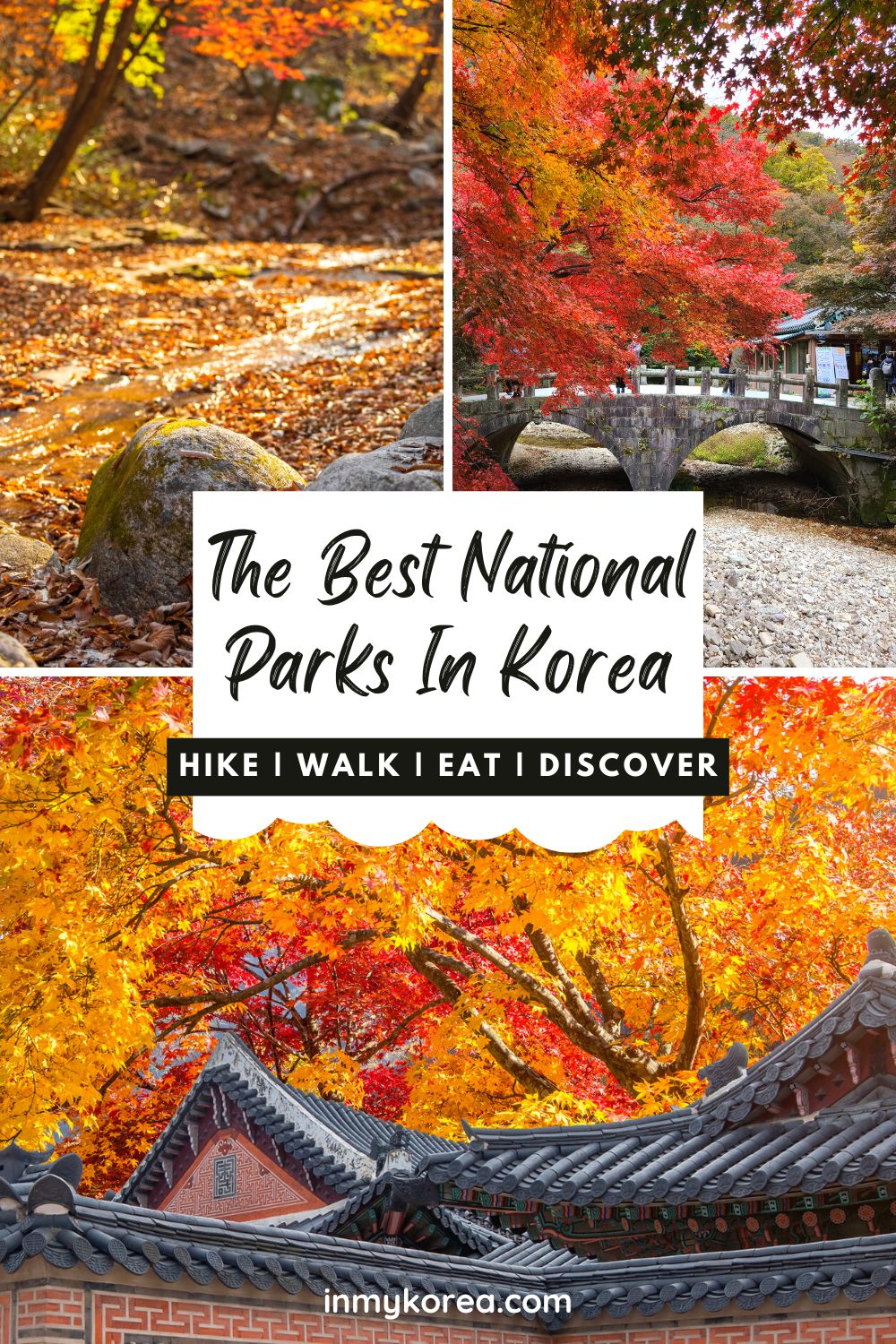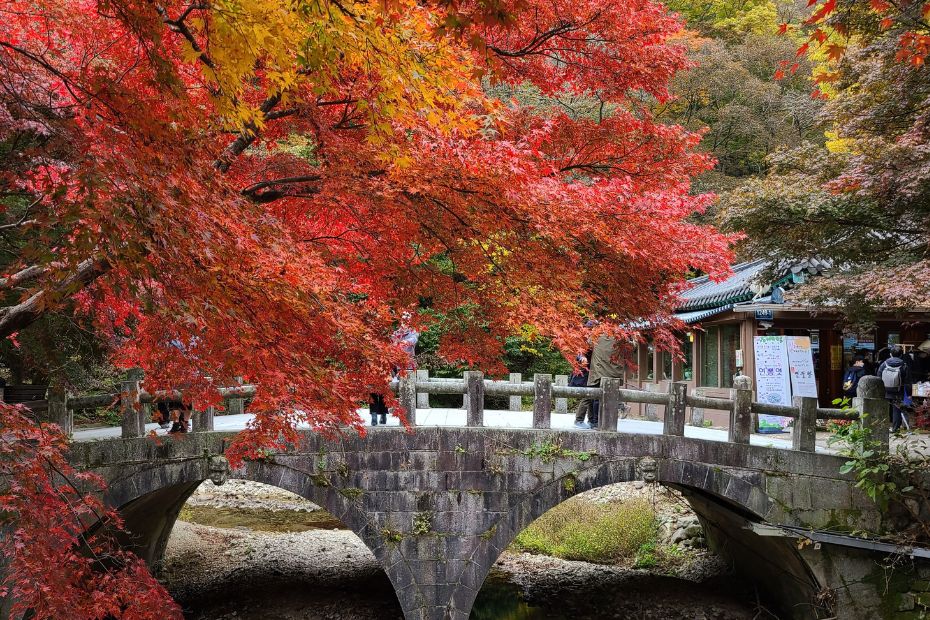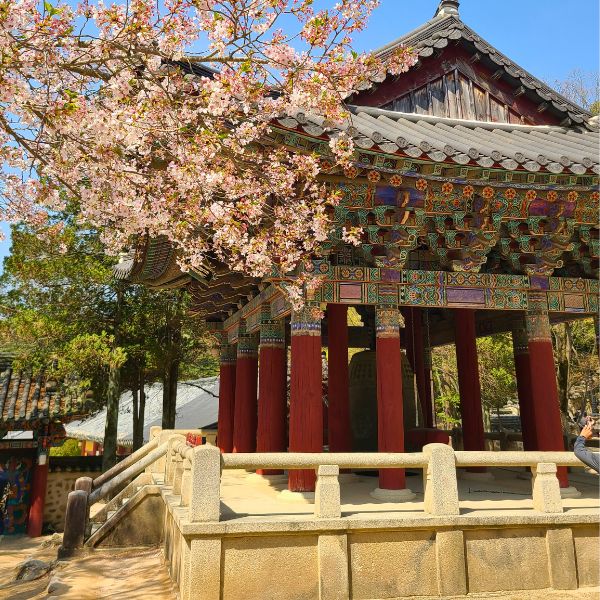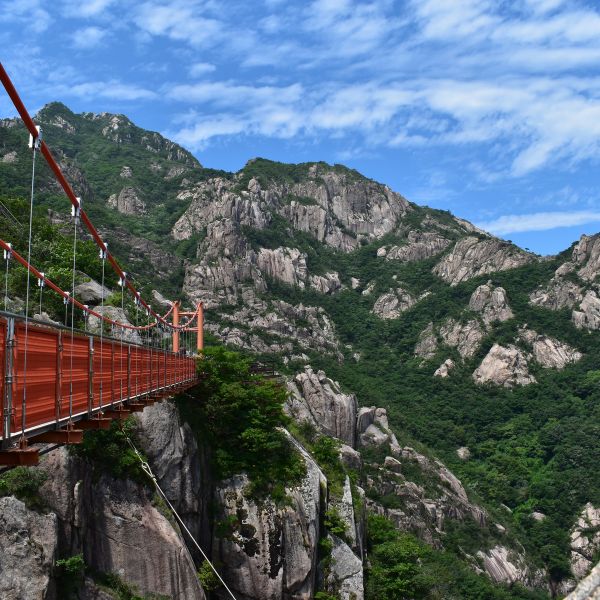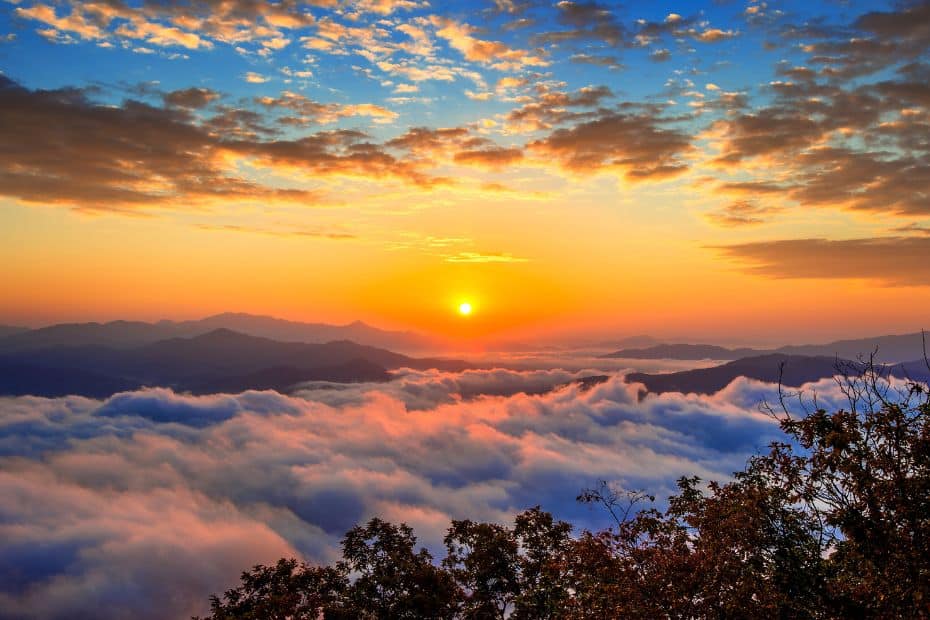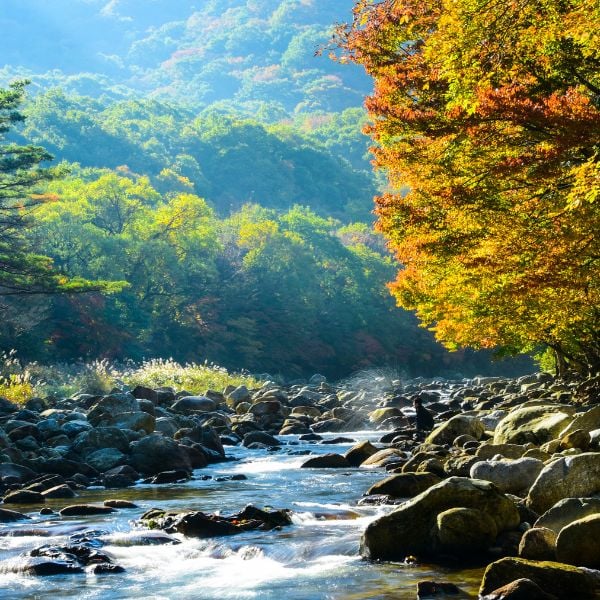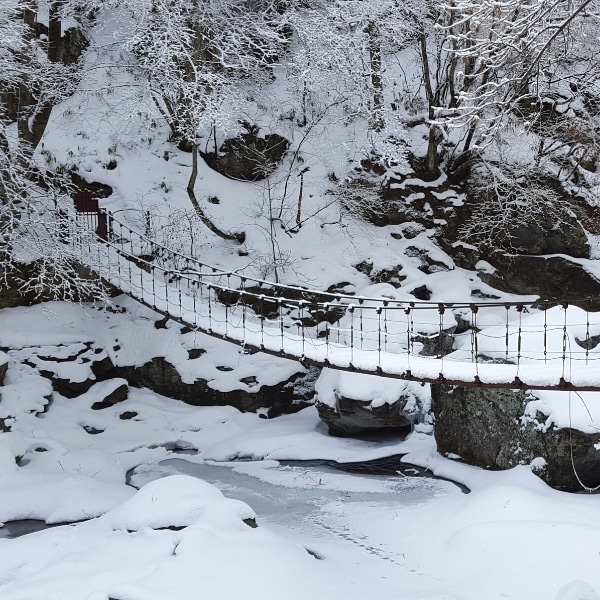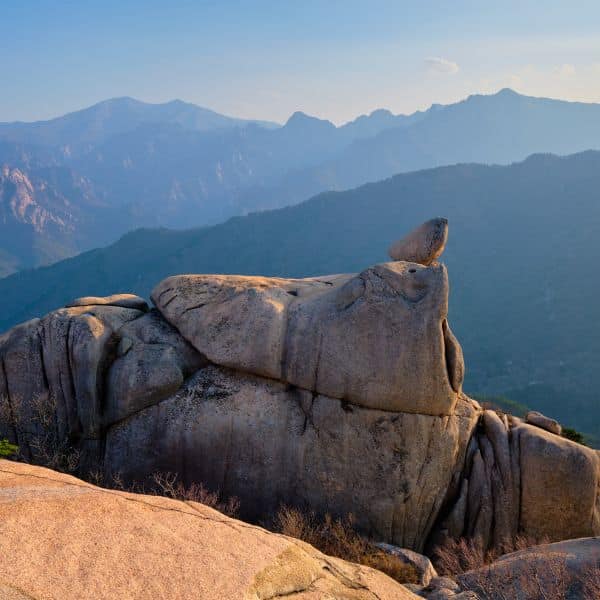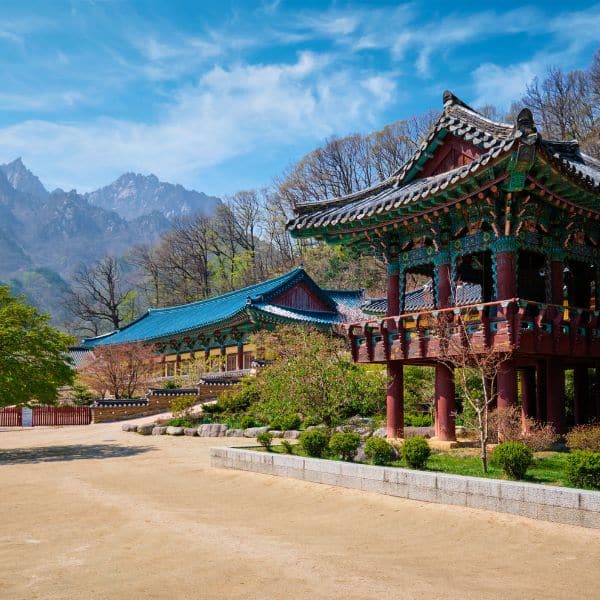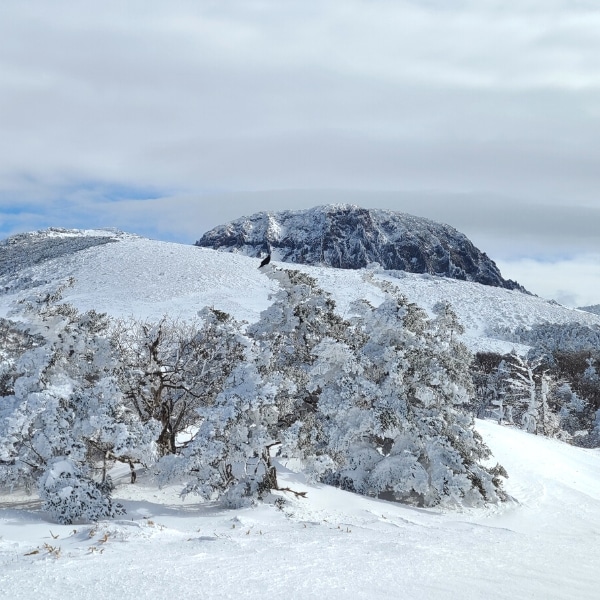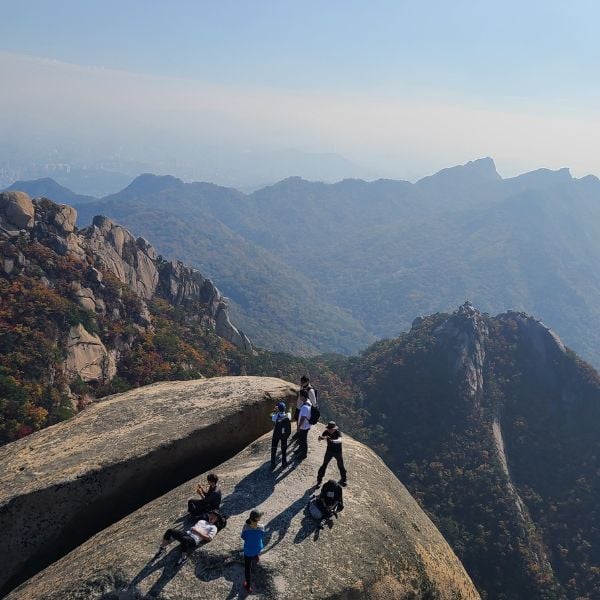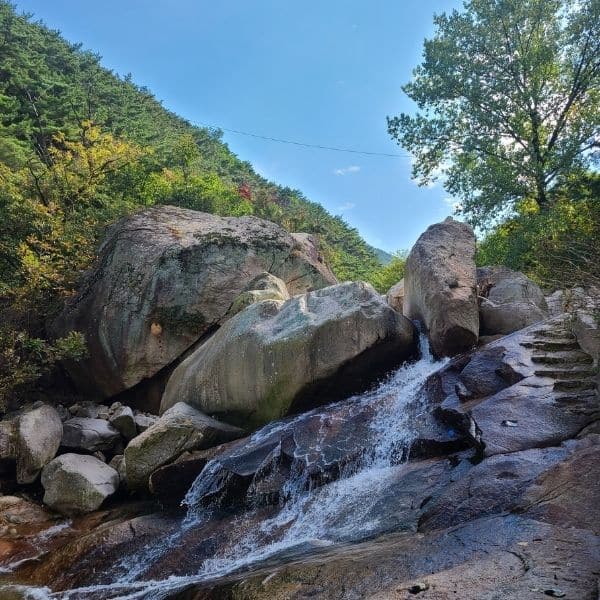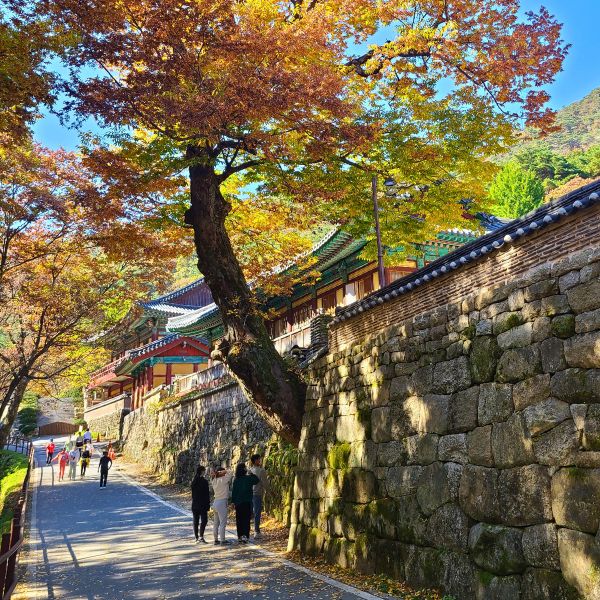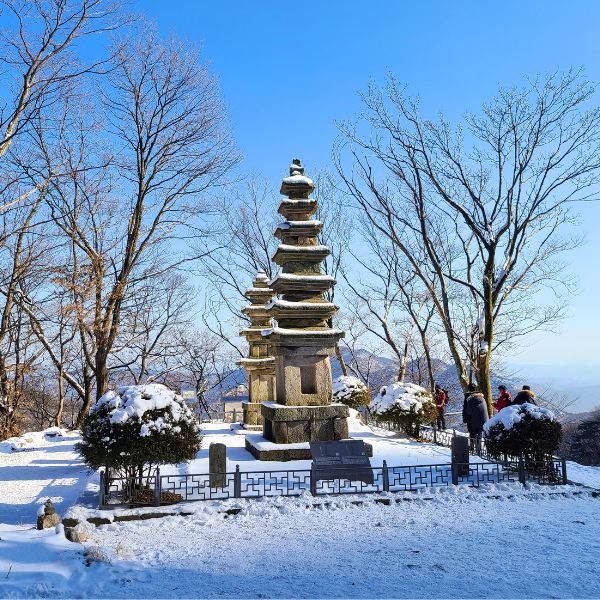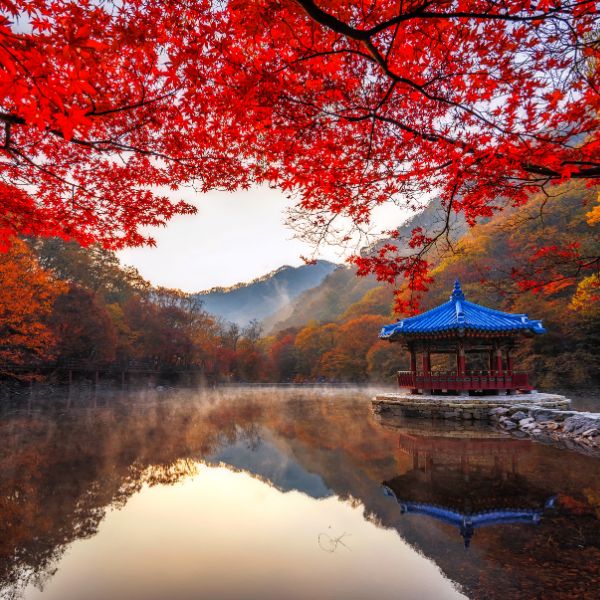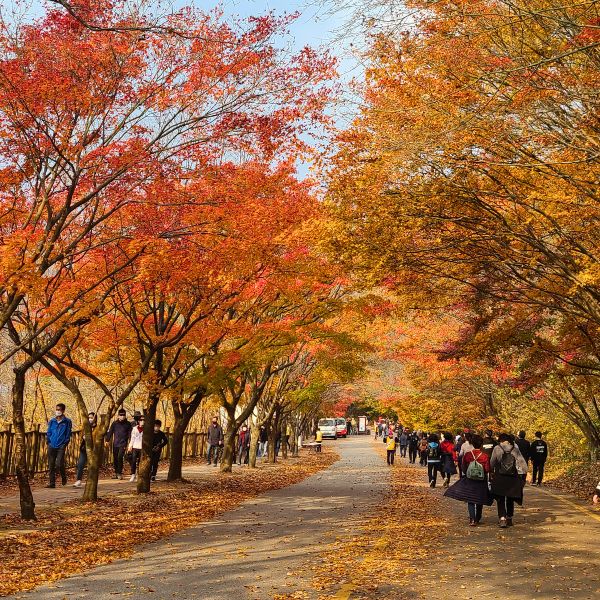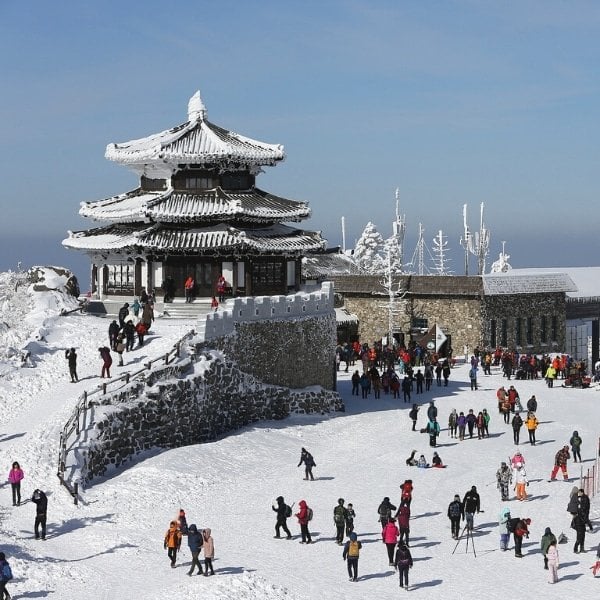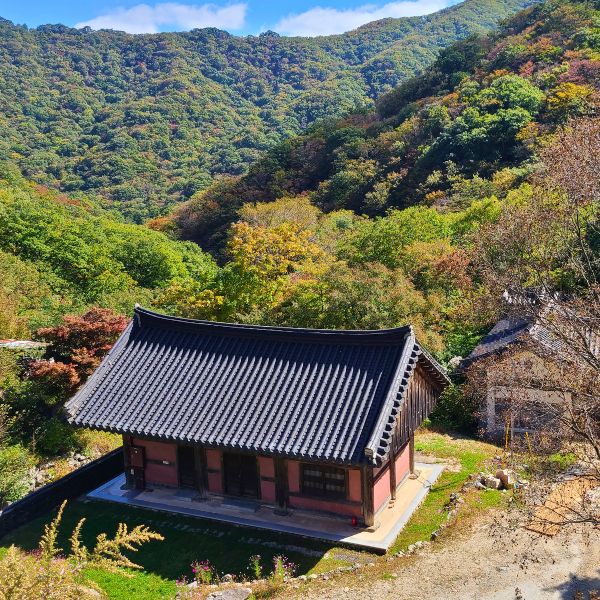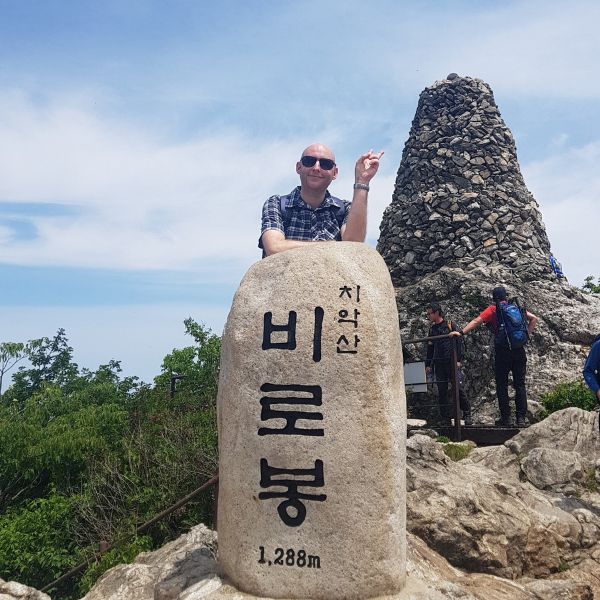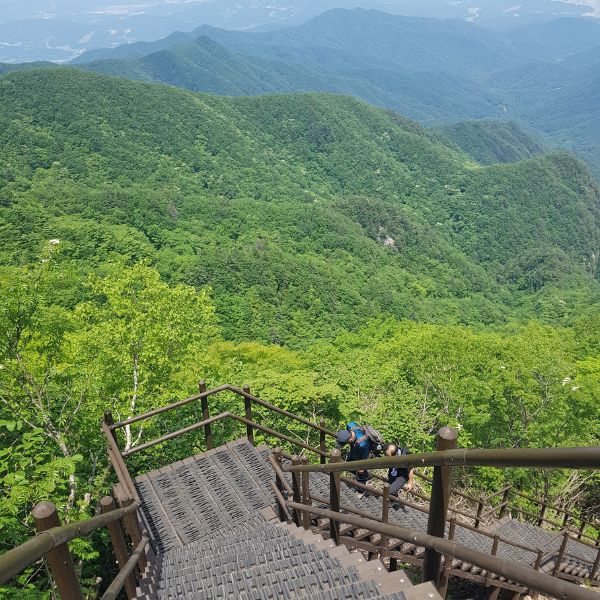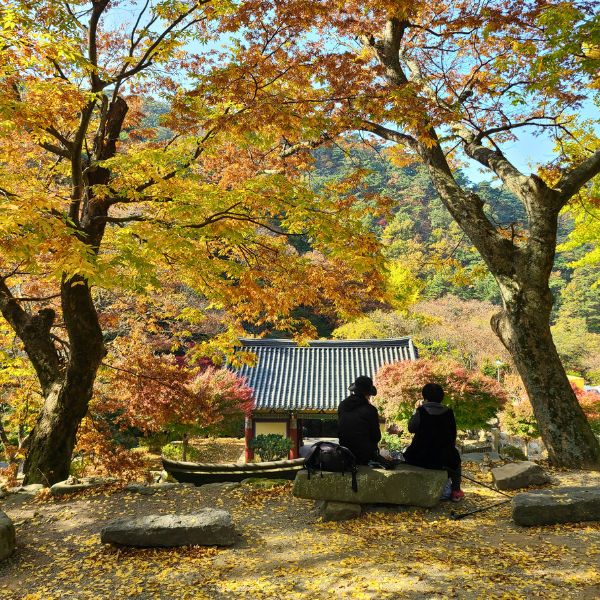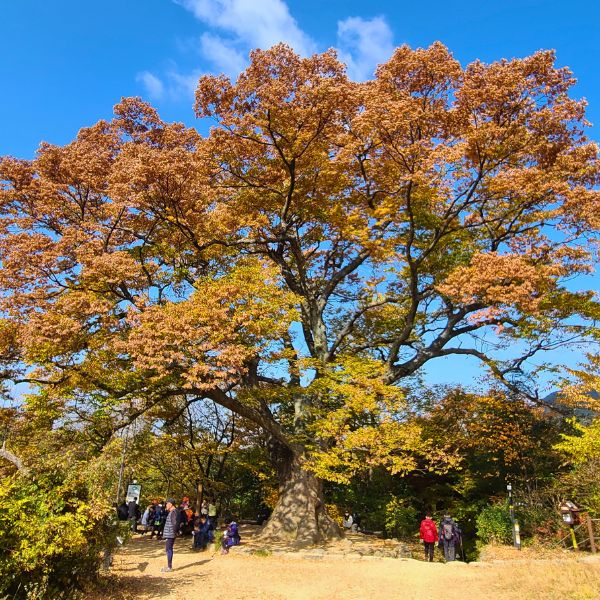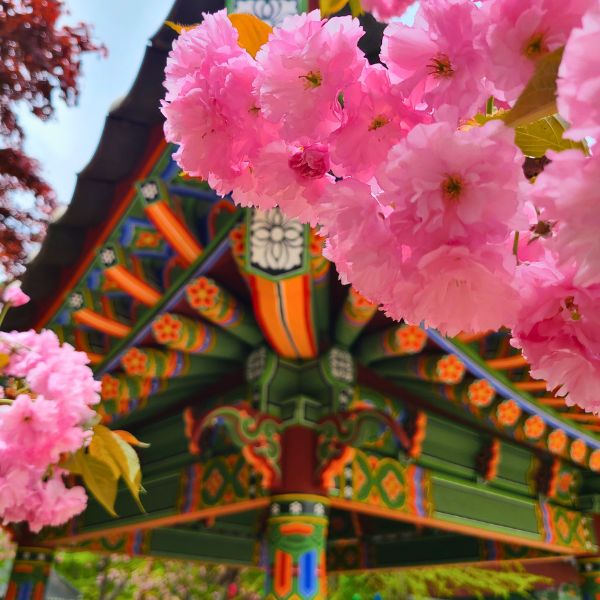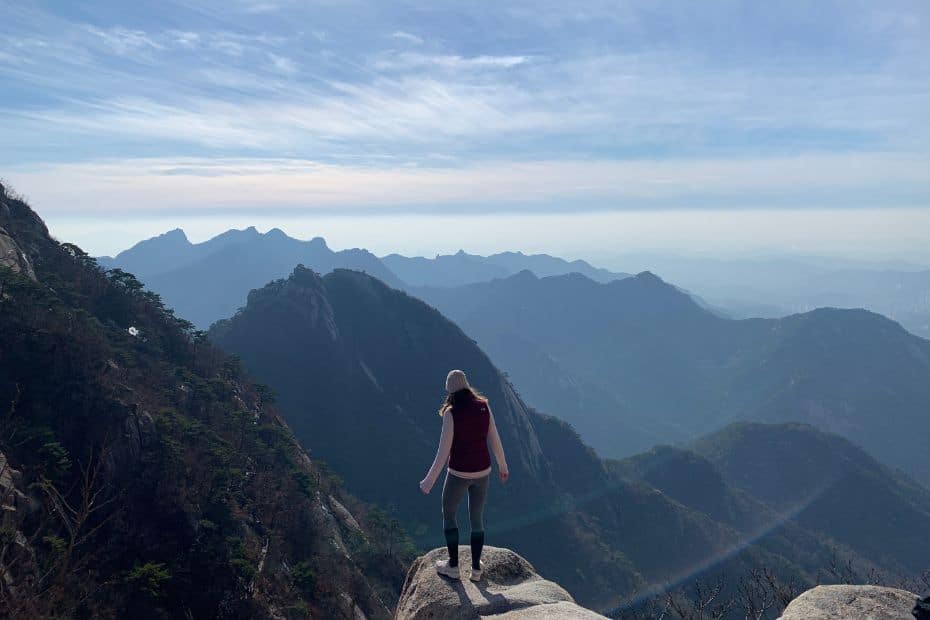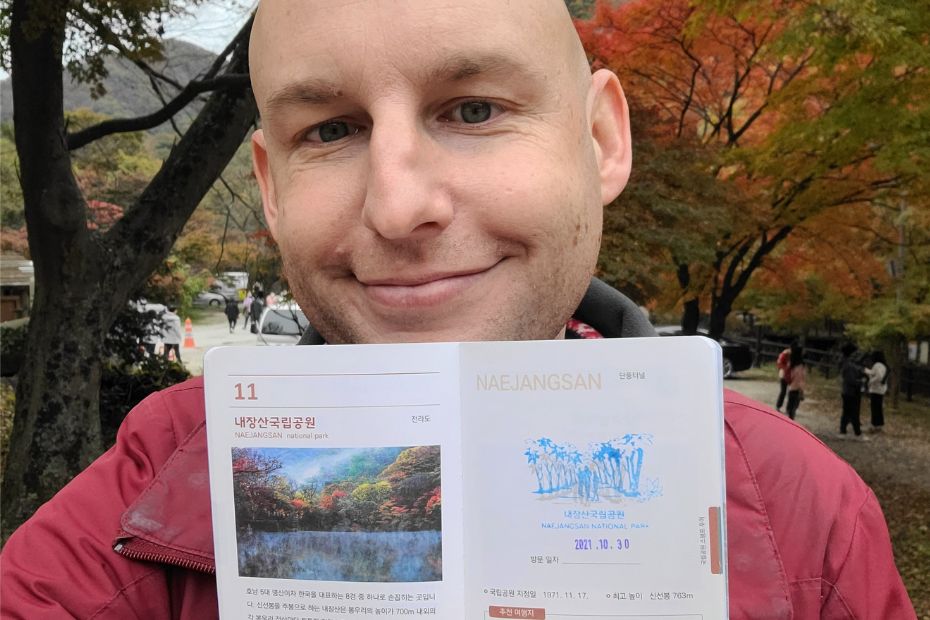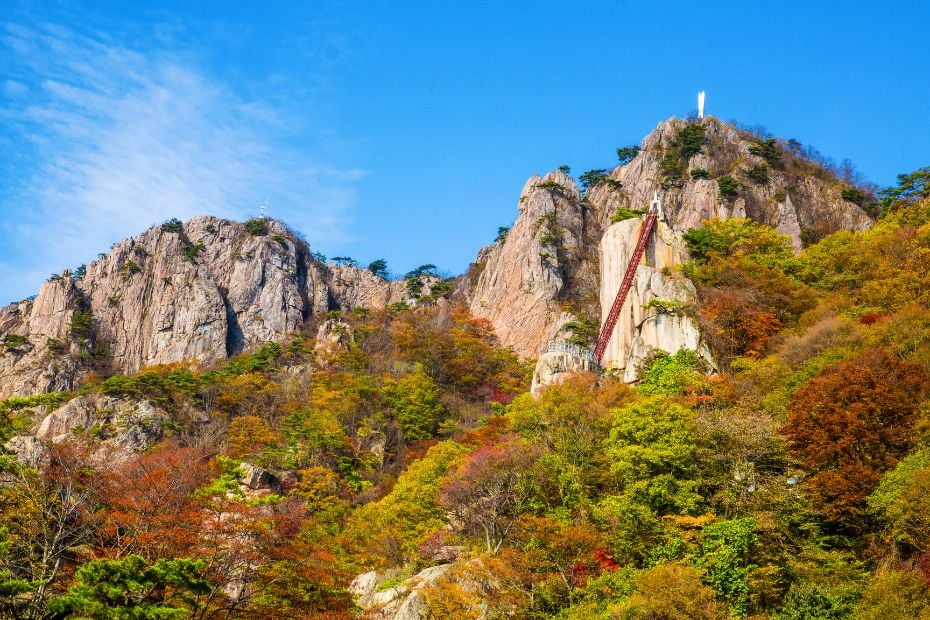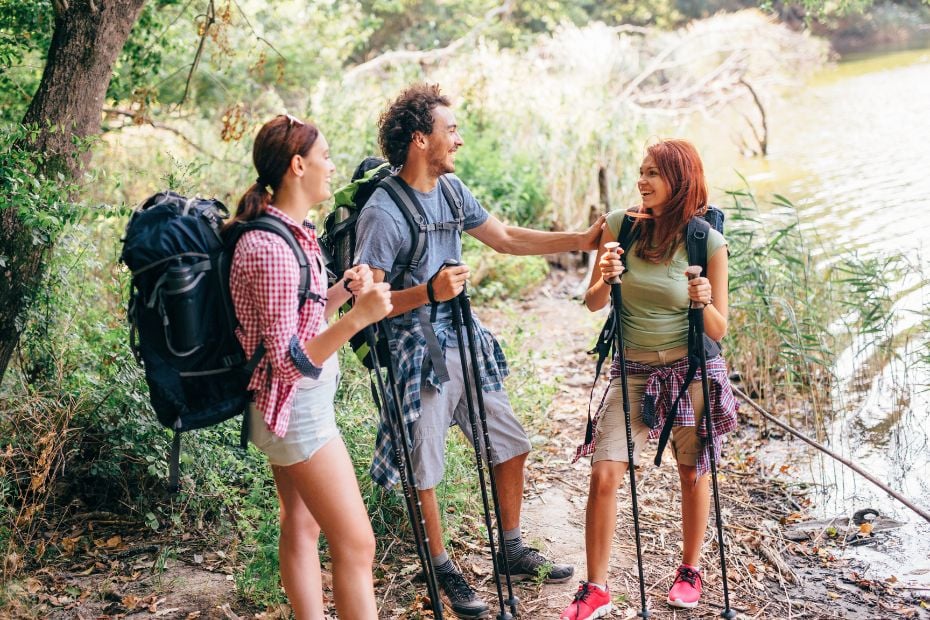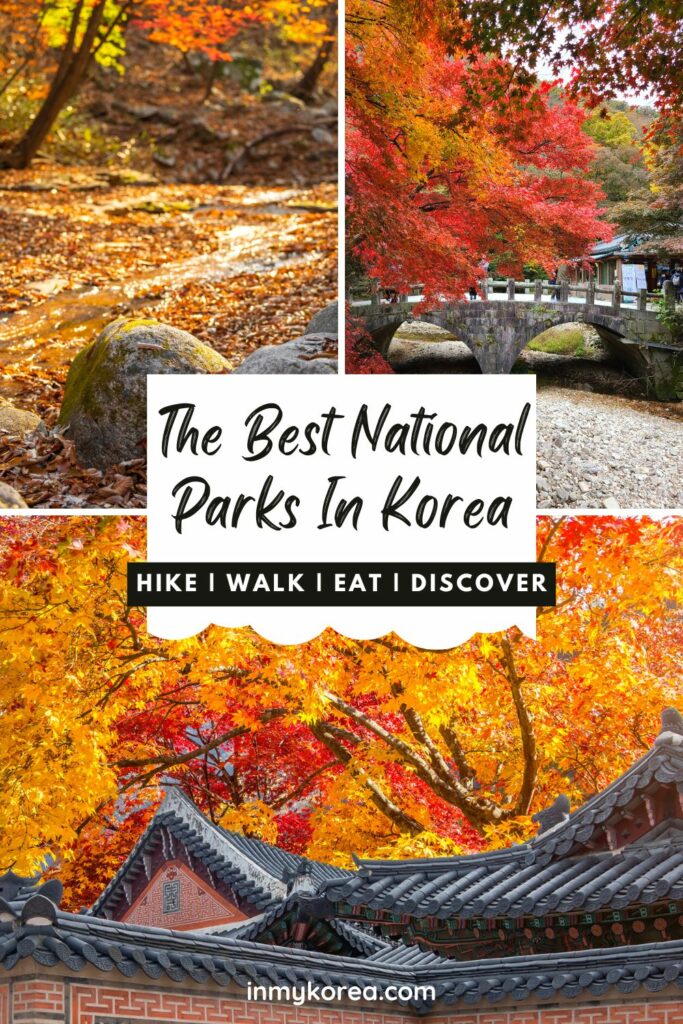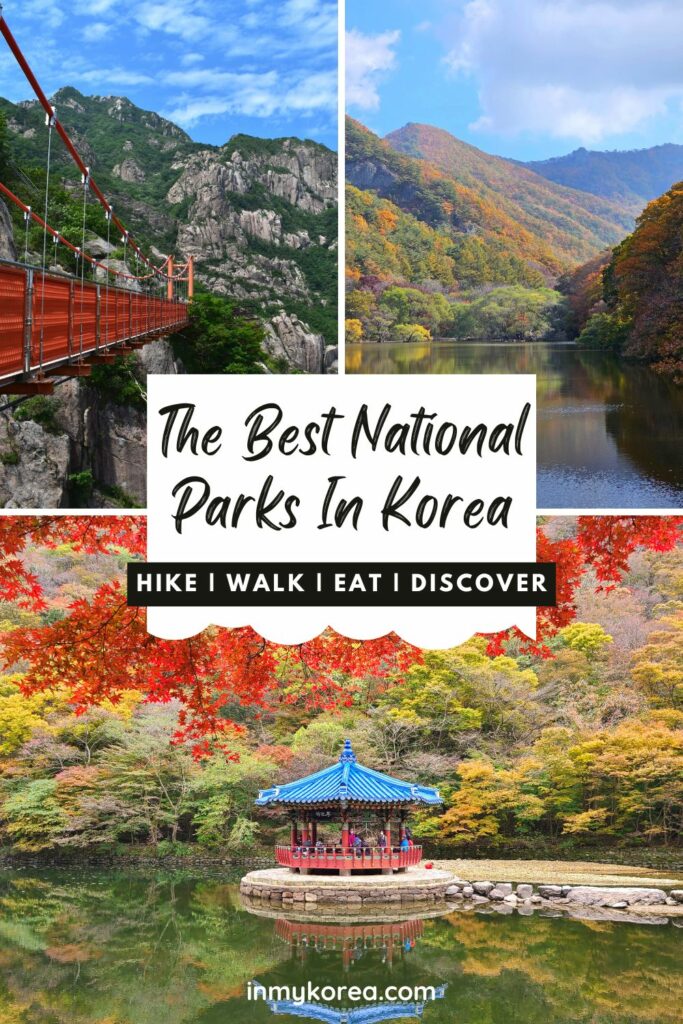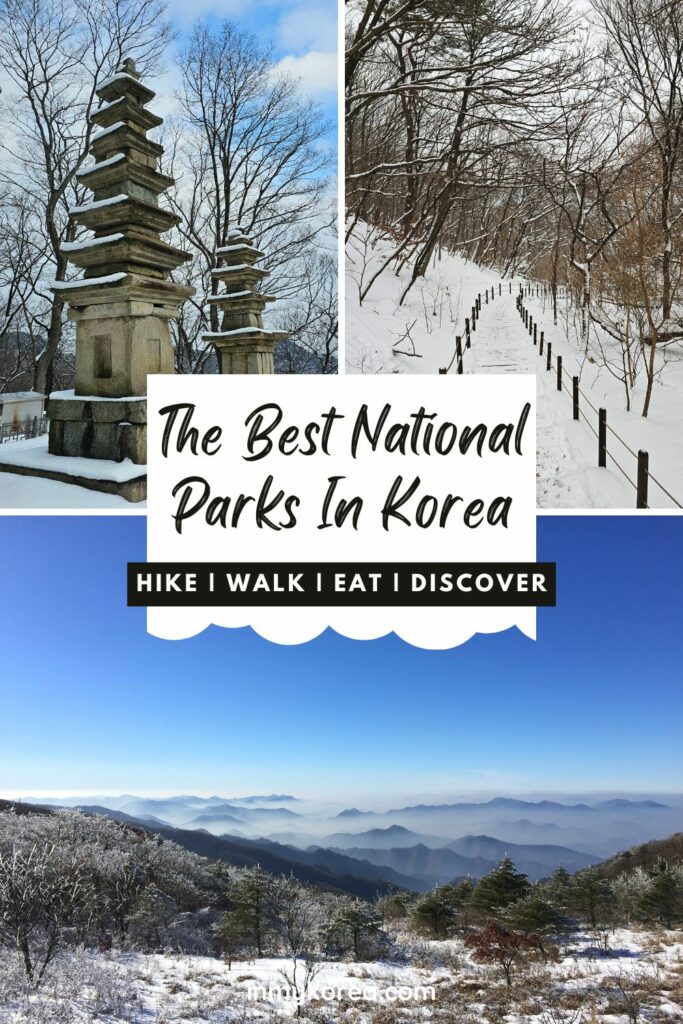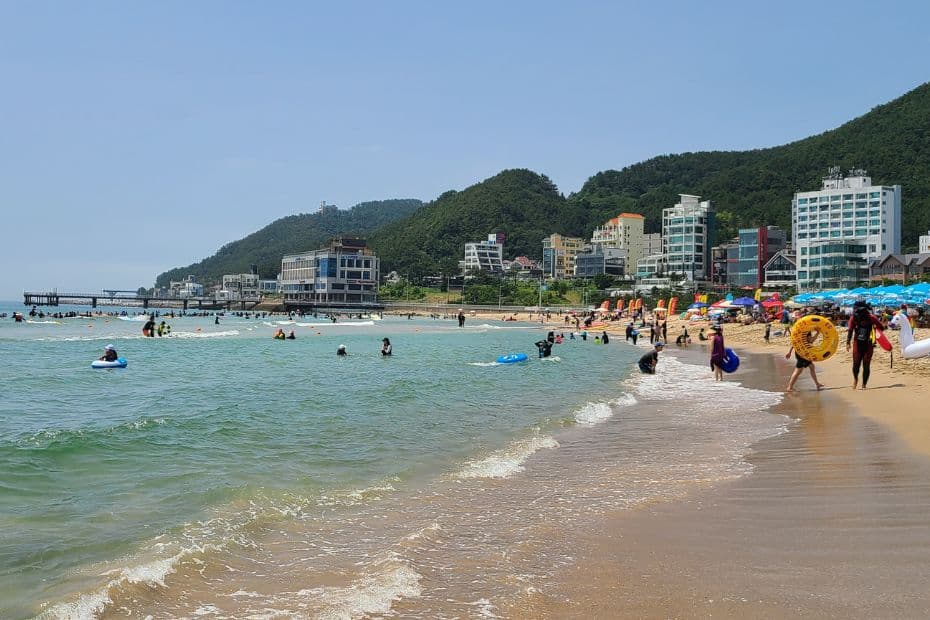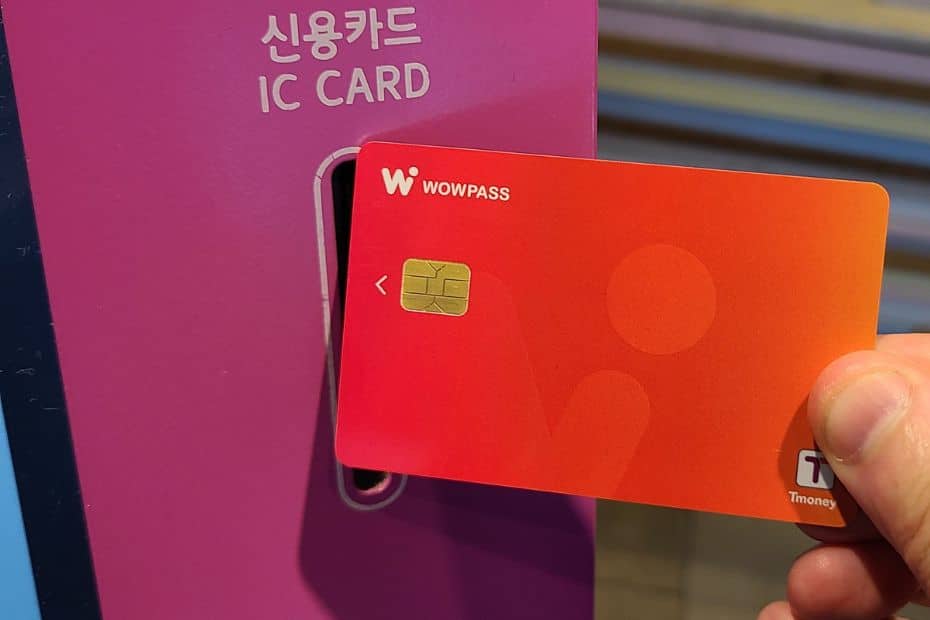Travelling to Korea and want to know which are the best national parks near Seoul? Want to experience more of Korea than just the big cities and beaches? Ready to take on a day of hiking and trekking through mountainous national parks with incredible views at any time of the year? Then this guide to the 10 best national parks in Korea will be essential reading for you.
Replete with natural beauty, historic sights, and awe-inspiring landscapes, Korea’s national parks are waiting for you to discover their charms. Whether visiting for spring splendour, summer shade, autumn foliage sights, or snowy winter fun, there’s a national park in Korea you’re sure to fall in love with.
Find out which are the best national parks in Korea to visit (there are 22 to choose from), what to see and do in each one, and why you simply must visit these areas of outstanding beauty. Be prepared to discover ancient temples where you can join a temple stay, stunning natural wonders such as waterfalls and rock formations, sweeping vistas from lofty peaks, and delicious traditional Korean dishes.
Affiliate Disclaimer: This site contains affiliate links and I may earn commission for purchases made after clicking these links.
Why Visit Korea’s National Parks?
Korea is a nature-lover’s paradise, with dozens of stunning national parks combining forests, mountains, streams, waterfalls, Buddhist temples and sometimes even coastal scenery. From the otherworldly lava tubes of Hallasan National Park to the iconic Mt. Seoraksan with its autumn foliage, Korea’s national parks offer incredible hiking, photo ops, and serene natural escapes.
Whether you’re looking for challenging all-day treks or easygoing trails the whole family can enjoy a day out at a Korean national park. Some of Korea’s national parks even have cable cars to whisk you straight up to the best views around. And the best part? Several of these wilderness gems are just a short distance from Seoul, making them easy weekend getaway destinations.
Here are 10 of the top national parks in Korea that should be on any nature-enthusiast’s bucket list. I’ve covered the highlights and main attractions of each as well as travel tips like the best times to visit and top activities. Read on for your definitive guide to seeing the best national parks in Korea.
Here are 5 great reasons you should visit a Korean national park:
- Seasonal delights: Blossoms in spring, leafy valleys in summer, fiery foliage in autumn, and snowy peaks in winter.
- Buddhist temples: Korea’s national parks are home to some of the most incredible Buddhist temples in the country.
- Traditional food: Try popular traditional dishes such as pajeon and bibimbap, as well as snacks like hotteok.
- Great exercise: A day in the great Korean outdoors is good for your body and mind with lots of fitness opportunities.
- Amazing sights: Every park is unique and offers stunning views over Korea’s rugged landscape and many shores.
Which National Park Should You Visit In Korea?
If you are looking for a certain experience when you visit a Korean national park, such as autumn foliage, hiking, snowy peaks, or traditional food, then check out the table below. It shows you some of the best options for various activities and sights and which park best suits those needs. Of course, most parks will offer seasonal views like cherry blossoms, autumn foliage, and snow.
| What are you looking for? | You should visit… |
|---|---|
| Cherry blossom views | Jirisan / Bukhansan / Gyeryongsan |
| Autumn foliage | Naejangsan / Bukhansan / Seoraksan |
| Winter hiking | Deogyusan / Seoraksan / Hallasan |
| Buddhist temples | Songnisan / Seoraksan / Gyeryongsan |
| Family-friendly trekking | Seoraksan / Jirisan / Naejangsan |
| Challenging hikes | Chiaksan / Seoraksan / Jirisan |
| Easy access from Seoul | Bukhansan / Chiaksan / Seoraksan |
| Weekend retreat | Jirisan / Seoraksan / Mudeungsan |
| Hiking on Jeju Island | Hallsan National Park |
Planning to visit Korea? These travel essentials will help you plan your trip, get the best deals, and save you time and money before and during your Korean adventure.
Visas & K-ETA: Some travellers to Korea need a Tourist Visa, but most can travel with a Korean Electronic Travel Authorisation (K-ETA). Currently 22 Countries don’t need either one.
How To Stay Connected: Pre-order a Korean Sim Card or a WiFi Router to collect on-arrival at Incheon Airport (desks open 24-hours). Alternatively, download a Korean eSIM for you travels.
Where To Stay: For Seoul, I recommend Myeongdong (convenient), Hongdae (cool culture) or Gangnam (shopping). For Busan, Haeundae (Beach) or Seomyeon (Downtown).
Incheon Airport To Seoul: Take the Airport Express (AREX) to Seoul Station or a Limo Bus across Seoul. Book an Incheon Airport Private Transfer and relax to or from the airport.
Korean Tour Operators: Tour companies that have a big presence in Korea include Klook, Trazy, Viator, and Get Your Guide. These sites offer discounted entry tickets for top attractions.
Seoul City Passes: Visit Seoul’s top attractions for free with a Discover Seoul Pass or Go City Seoul Pass. These passes are great for families and couples visiting Seoul – you can save lots.
How To Get Around: For public transport, grab a T-Money Card. Save money on Korea’s high speed trains with a Korea Rail Pass. To see more of Korea, there are many Rental Car Options.
Travel Money: Use money exchanges near Myeongdong and Hongdae subway stations for the best exchange rates. Order a Wise Card or WOWPASS to pay by card across Korea.
Flights To Korea: I use flight comparison sites such as Expedia and Skyscanner to find the best flights to Korea from any country. Air Asia is a good option for budget flights from Asia.
How To Learn Korean: The language course from 90 Day Korean or Korean Class 101 both have well-structured lessons and lots of useful resources to help you learn Korean.
The 10 Best National Parks In Korea
Here are the top 10 best national parks in Korea, based on my own travels around Korea, reports from other hikers, and national parks that are really popular with locals and tourists alike. I hope you visit at least one, if not all of them. They each have something unique to offer and I’ve enjoyed visiting each.
1: Jirisan National Park
Why visit Jirisan: Jirisan is Korea’s largest national park and home to the mainland’s highest peak, as well as some of Korea’s last Asiatic black bears. This national park offers something for everyone, with multi-day hiking trails through the mountains or gentle day-treks around the foothills and through green valleys. Wander through old villages where people live a simpler life than in Seoul.
This national park is one of the only places that offers mountain lodges where you can stay overnight to watch the sunrise over the sprawling mountains below. Jirisan has many farms and maple trees, making it one of the best places to see harvest goods and autumn foliage in September and October. There’s never a bad time to visit Jirisan as there’s something to see and do in each season.
You should visit this national park if you want to see the Korean countryside, walk past rice fields and farms, and witness Korea’s natural beauty.
Best hiking trail: The best hiking route in Jirisan National Park is the Jungsanri to Cheonwangbong Loop, which will take you to the highest peak in the park. This route can be done in a day, but it’s very tough and I recommend booking a lodge to stay overnight. Staying overnight allows you to see the sunrise from the peak, which is absolutely incredible.
How to get to Jirisan: Jirisan National Park isn’t close to Seoul. If you want to visit, it would be best to travel by bus or car from Busan, Daejeon, Gwangju, or one of the other cities in southern Korea. Nearby towns to stay in with access to the park include Namwon, Gurye, and Hadong.
Highest Peak:
Cheongwangbong Peak (1,915m)
Best Time to Visit:
Autumn or spring, winter for snow hiking.
Suitable For:
Courses available for all levels.
Where to Stay:
Namwon, Gurye, or Hadong (towns).
2: Seoraksan National Park
Why visit Seoraksan: Located near Korea’s east coast, Seoraksan National Park hosts towering mountain peaks and sweeping valleys smothered in foliage views each autumn. As one of Korea’s most beloved natural escapes with peak panoramas, it attracts over 5 million visitors annually. Even if you don’t climb to the peaks, you can spend hours exploring the temples and valleys of Seoraksan.
Popular with both hikers and day travellers, Seoraksan caters to all thanks to attractions like Sinheungsa Temple and the Seoraksan cable car, which will take you to the peak without the need to hike. If you do want to hike, there are many suitable courses, including the short trip to Ulsanbawi Peak and overnight hiking options with shelters to stay in. There are also many waterfalls to see.
You should visit this national park if you want to see what Korea’s national parks have to offer all in one place, including Buddhist temples, seasonal views, and rocky peaks. A day trip from Seoul will allow you to see the sights of Seoraksan without any hiking gear or travel troubles.
Best hiking trail: One of the most popular trails is the short route up to Ulsanbawi Peak, which starts at the eastern entrance and passes by Sinheungsa Temple. It’s not the highest peak, but offers views over the valleys and peaks of Seoraksan with a rocky area to discover at the top. Alternatively, the Biseondae Rock trail is perfect for beginner level hikers and follows the valley paths.
How to get to Seoraksan: Seoraksan is 2.5 hours away from Seoul by car or bus. Tours from Seoul will take you to the main entrance of the park and guide you around the top spots, too. The nearest city to Seoraksan is Sokcho and this is a nice place to stay for a weekend of hiking and beach fun.
Find out how to get to Seoraksan, what there is to see and do, where to stay, and lots more essential info in my detailed guide to visiting Seoraksan National Park.
Highest Peak:
Daecheongbong Peak (1,708m)
Best Time to Visit:
Autumn, but any time is good to visit.
Suitable For:
Courses available for all levels.
Where to Stay:
Travel from Seoul or stay in nearby Sokcho City.
3: Hallasan National Park
Why visit Hallasan: Dominating the centre of Jeju Island, Hallasan National Park is famous for offering the only place to hike to the top of a (technically) active volcano in Korea. Although the crater is filled in at the top, leaving a dome that fills with water during summer, the views from the almost 2km high peak allow you to see the whole of Jeju and the rugged coastline stretching out all around.
If you visit Jeju Island during winter, you can see the snow-capped peak while you’re sitting on a sandy beach and, even if it’s clear and calm on the shore, there can be knee-deep snow covering the whole of the national park. This national park only has one peak, but it’s one of the most impressive. You can also see many ‘oreums’ – hardened hills of lava deposits leftover from previous eruptions.
You should visit this national park if you want to stand on the highest point in South Korea and gaze out at the shore in all directions from a UNESCO World Heritage Site. This park offers easier hiking trails that lead up slowly and steadily, making them more accessible.
Best hiking trail: The Seongpanak Trail that leads to the peak of Hallasan is definitely the best hiking trail to follow if you want a full-day hike that’s not too steep. The long, slow trek to the top rewards you with views across the whole island. Alternatively, take the Yeongsil Trail for an easier, shorter hike that will show you Jeju’s west coast.
How to get to Hallasan: For the Seongpanak Trail start point, take bus #281 or #181 from Jeju Intercity Bus Terminal (heading to Seogwipo) for 40 minutes. For the Yeongsil Trail start point, take bus #240 from Jeju City Intercity Bus Terminal (heading to Jungmun) for 50 minutes. Get off at the Yeongsil Ticket Office and follow the path to the trail entrance for 2.5km.
Find out how to hike Hallasan during winter, including how to make a reservation, how to get to the park, and lots of other travel tips for surviving this snowy hike in my detailed guide to hiking Hallasan in winter.
Highest Peak:
Hallasan (1,950m)
Best Time to Visit:
Winter to see snow on a semi-tropical island.
Suitable For:
People who can trek all day
Where to Stay:
Jeju City or Seogwipo City.
4: Bukhansan National Park
Why visit Bukhansan: Bukhansan may be relatively small, but its close proximity to Seoul makes it one of the most visited national parks in Korea (per unit area), according to the Guinness Book of Records. The reason for its popularity is evident when you consider that it offers the chance to escape the bustling city and find peace and harmony in nature with lots of scenic beauty all around.
Bukhansan National Park offers a range of hiking trails, including the breathtaking Baegundae Peak, which can be completed in a few hours, or combined for a full day out in nature. Besides hiking trails, there are traditional restaurants near the park’s entrances, Buddhist temples, and the Bukhansan fortress walls to see. This is one of my favourite places to see autumn foliage near Seoul.
You should visit this national park if you want to hike in a Korean national park while visiting Seoul and see the city from a new perspective. Bukhansan offers the best chance to experience temples and traditional food with mountain views close to the capital.
Best hiking trail: If you want to see just how big Seoul is, take the hike to Baegundae Peak, the park’s highest peak. Although it’s relatively small compared to the peaks of other national parks, you’ll be left speechless (and breathless) when you scale the rocky slabs to gaze out in all directions.
How to get to Bukhansan: For the hike to Baegundae Peak, take the subway to Gupabal Station (구파발역) on Line 3, go out Exit 1 and take bus 34, 704, or 8774 to the Bukhansan Fortress Entrance stop.
Find out how to hike Baegundae Peak, including how to get there, which courses to follow, and lots of other hiking tips for Bukhansan in my detailed guide about how to hike Baegundae Peak.
Highest Peak:
Baegundae Peak (845m)
Best Time to Visit:
Autumn, but any time is good as it’s shaded.
Suitable For:
People who are used to trekking or hiking.
Where to Stay:
Anywhere in Seoul, (Myeongdong or Hongdae).
5: Gyeryongsan National Park
Why visit Gyeryongsan: This small national park close to Daejeon doesn’t have the tall peaks you’ll find in Seoraksan or Jirisan, but it has many other charms that make it worth visiting. The main hiking courses take you to one of two peaks (or both in a loop), passing by unique sights like twin pagodas, a long waterfall, and a rest spot half way up that looks out over the green valleys below.
This national park has a good selection of cafes to visit, where you can grab a cake and coffee and stare out at the small mountains surrounding you. I spend many weekends in Gyeryongsan – hiking in the morning and taking in the views from a cafe in the afternoon – especially in spring as this is one of the best places to see cherry blossoms near Daejeon, although I hike here year round.
You should visit this national park if you want to see streets lined with cherry blossom trees in early April and pretty hiking trails all year round. Not the most impressive park, but a peaceful one that has something for everyone and plenty of places to try traditional Korean dishes, including haemul pajeon.
Best hiking trail: If you want a short hike, take the slow path to Sambulbong Peak, which passes by the Nammaetap twin pagodas. You can reach the peak in a couple of hours and then turn around or continue on to Gwaneumbong Peak by following the ridge. This extension will lead you round to Donghaksa Temple and takes about 5-6 hours to complete. Bring some lunch with you.
How to get to Gyeryongsan: From Seoul, travel to Daejeon on the KTX, then take bus #107 from Daejeon Station all the way to the Donghaksa Temple stop, which is the main entrance of the park and the final stop for the bus.
Highest Peak:
Gwaneumbong Peak (845m)
Best Time to Visit:
Spring for blossom views, but any time is good.
Suitable For:
Experienced hikers and anyone fit.
Where to Stay:
Stay in Daejeon City for easy access.
6: Naejangsan National Park
Why visit Naejangsan: Famed as one of the best spots to see autumn leaves in Korea, Naejangsan is a splendid place to immerse yourself in Korea’s natural beauty. At the entrance of the park is the colourful Maple Tree Tunnel, which leads you to a wide central area with a cable car and traditional restaurants and the historic Naejangsa Temple. The park is easy to explore for all visitors.
Naejangsan has been listed as one of the top 10 most beautiful places in Korea and is home to many famous sights, including the Yeonjabong Peak Observatory (accessed by cable car), Naejangsa Temple area, and the Uhwajeong Pavilion. The Uhwajeong Pavilion, which reflects beautifully in the surrounding lake, is considered an iconic sight to see in Korea, especially in autumn.
You should visit this national park if you want to see some of the most beautiful autumn foliage sights in Korea in early November. This park is worth visiting in other seasons and has many attractions to see and isn’t as crowded as parks like Bukhansan or Seoraksan.
Best hiking trail: One of the most popular routes is the Naejangsan outer loop, which follows the peaks around the central area of the park. If you want a shorter hike, head to Sinseonbong Peak, the park’s highest peak. The trail starts near Naejangsa Temple, but you can take a shortcut by taking the cable car. This route isn’t too long, but it’s quite tough in places, especially near the peak.
How to get to Naejangsan: Take the KTX from Yongsan Station to Jeong-eup Station, then take a local bus to Naejangsan National Park. Naejangsan is quite far south, so it might be better to include it if you visit Gwangju, Jeonju, or Daejeon. There should be tours that will take you directly there from Seoul during autumn.
Find out all there is to see and do in Naejangsan National Park in fall, including how to get there, what to eat, and what to see, in my guide to visiting Naejangsan for autumn foliage.
Highest Peak:
Sinseonbong Peak (763m)
Best Time to Visit:
Autumn (late October to early November)
Suitable For:
Everyone.
Where to Stay:
Travel from Seoul or stay in Jeong-eup City.
7: Deogyusan National Park
Why visit Deogyusan: This is one of my favourite national parks in Korea for winter hiking because the main trail to Hyangjeokbong Peak has so many beautiful sights. It starts following the river along a valley, before climbing to a hidden temple in the mountains, then a steep ascent into the heavens with open views at the peak. But the wonders continue with a beautiful pagoda just past the peak.
The big advantage of Deogyusan National Park over other national parks, especially in winter, is that it connects to Muju Ski Resort. You can hike up in the morning and ride down to the ski resort for a late lunch of ramyeon and hot coffee. The 1,614 metre high peak is accessible even to those who don’t want to hike, so you can embrace the long vistas with or without a morning of hiking behind you.
You should visit this national park if you want to see incredible snow scenes in winter or picturesque foliage in other seasons. The cable car from Muju ski resorts allows you to experience the heights without the hassle of hiking. Autumn is another incredible time to visit this national park.
Best Hiking Trails: The Gucheondong Valley trail going to Hyangjeokbong Peak, is one of the best hiking trails in this park. This course is actually quite gentle for the first 6km, walking along the valley on the way to Baekyeonsa Temple. After that there’s 1.5km of tough but rewarding hiking to the peak, followed by a cable car ride to Muju Ski Resort where you can get a bus home.
How to get to Deogyusan: I wouldn’t recommend travelling to Deogyusan from Seoul. You can access Deogyusan from Daejeon, Muju, and other nearby cities. Buses run from Daejeon to Gucheondong Valley from Daejeon Bokhap Terminal. There’s a free shuttle bus from the Muju Ski Resort to the town of Muju. From Muju, you can take buses to Daejeon, Seoul, and other cities in Korea.
Highest Peak:
Hyangjeokbong Peak (1,614m)
Best Time to Visit:
Winter, but autumn is also amazing.
Suitable For:
Experienced hikers (unless taking the cable car)
Where to Stay:
Muju City or Daejeon.
8: Chiaksan National Park
Why visit Chiaksan: This national park near Seoul has some medium-sized mountains that don’t compare in size to the lofty peaks of Jirisan or Seoraksan, but offer a serious challenge to hikers eager to explore its forested paths. Chiaksan is blessed with many steep valleys and thick forests, offering some truly stunning views, including some interesting granite rock formations and waterfalls.
This national park caters more to hiking enthusiasts than day-trippers looking to see some sights, however, there is still plenty to see if you’re willing to put in the effort. Brave hikers will be rewarded with sights such as Taejongdae Rock, Guryongsa Temple, and the lovely Seryeom Waterfall. You don’t need to be super fit to hike here, but definitely be prepared to sweat a bit.
Fun fact: Chiaksan is one of the toughest national parks to hike in Korea. Korean peaks with ‘ak’ in them (including Wor-ak-san & Seor-ak-san) indicate they are difficult, although the mountains use different Hanja (Chinese characters), so it’s hard to tell just how true that is. Another translation of the ‘ak’ Hanja in Chi-ak-san (岳) is ‘parents-in-law’, something people might also describe as tough!
You should visit this national park if you want a tough, challenging hike in a forested national park and enjoy seeing unique geology and peaks. If you’re prepared to sweat a bit, you’ll definitely love the hikes here, although there are shorter trails available, too.
Best hiking trail: The path to Birobong Peak, the highest point in the park, is one of the most popular trails, offering challenging terrain and rewarding views. This path starts at the Guryong Information Centre and after a gentle start gets up to ‘expert level’. For a less strenuous hike, the Guryongsa Temple trail provides a scenic walk through the park’s forests, leading to one of its cultural landmarks.
How to get to Chiaksan: Take bus #21, #41, or #82 bound from Guryongsa Temple / Chiaksan National Park from Wonju Bus Terminal. If you’re travelling from Seoul, take an intercity bus to Wonju Bus Terminal, or the train from Cheongnyangni Station to Wonju Station.
Highest Peak:
Birobong Peak (1,288m)
Best Time to Visit:
Any season. Spring is nice and cool.
Suitable For:
Experienced hikers.
Where to Stay:
Wonju City.
9: Mudeungsan National Park
Why visit Mudeungsan: Located close to Gwangju City in southern Korea, this is one of the newest and smallest national parks in Korea, but is still full of charm. Fans of geology will love the hexagonal rock formations near Seoseokdae Peak, formed from ancient volcanic activity, as well as the sheer rock faces that spring up out of the ground and look like they’ve been dropped by giants.
This park has lots of natural and cultural wonders to explore, including the spectacular Jeungsimsa Temple, home to picturesque autumn scenes with giant ginkgo trees covering the temple grounds in a blanket of yellow leaves. Just past this temple is the Dangsan Namu Guardian Tree – a giant tree that protects the local area. At the peak, there’s a nature reserve (Jangbuljae) and more to see.
You should visit this national park if you want to see unique volcanic rocks and a lovely Korean temple surrounded by tall trees. This park’s convenient location next to Gwangju City makes it ideal for anyone travelling to this part of Korea looking for a trip into nature.
Best hiking trail: The path to Seoseokdae Peak from Jeungsimsa Buddhist Temple is one of the best ways to see the main highlights in this compact Korean national park. The route isn’t that tough, slowly winding up roads and rocky paths before coming out to open plains. Follow the signposts all the way to the peak and return the way you came or head north over the peaks (Wonhyo Valley) for more views.
How to get to Mudeungsan: As this park is close to Gwangju, it’s best to travel to Gwangju Station and take a bus from there to the park entrance near Jeungsimsa Temple. There are cafes, restaurants and shops in this area and it’s the best place to start exploring the park from.
Highest (Accessible) Peak:
Seoseokdae Peak (1,100m)
Best Time to Visit:
Any time, but autumn views at the temple are great.
Suitable For:
Anyone moderately fit.
Where to Stay:
Gwangju City (near the station).
10: Songnisan National Park
Why visit Songnisan: This guide to national parks in Korea wouldn’t be complete without this hidden gem. Songnisan is an enchanting national park right in the heart of Korea that is packed with traditional Korean delights. I might be biased as I live near this park and have done a temple stay experience at Beopjusa Temple more than once, but if you visit, I think you’ll agree it’s lovely.
The main entrance to the park is packed with traditional Korean restaurants and local markets selling locally sourced foods, such as daechu (dates), wild mushrooms, and ginseng. Then it opens out into one of the most impressive Buddhist temples found in a national park – Beopjusa Temple. There’s a long walking path through the valley which leads out to various hiking paths in the park.
Giant cherry blossoms: If you want to see some truly impressive cherry blossom sights, then visit Beopjusa Temple near the end of April to see the King cherry blossoms on display. These large, fluffy blossoms (pictured below) are so soft and much larger than usual cherry blossoms. Partnered with the colourful temple buildings, they create some really spectacular scenes.
You should visit this national park if you want to see one of the best Korean Buddhist temples in Korea, a serene lake with turtles sunbathing on logs, Korean restaurants tucked away in the forest with waterfall views, and lots of leafy trees. You don’t need to hike to enjoy all that Songnisan has to offer.
Best hiking trail: The path to Cheonhwangbong Peak that starts from Beopjusa Temple is very rewarding. There are a few ways to get to this peak, which start after a couple of miles trekking along the valley floor following the river. Once you reach a pajeon restaurant by a waterfall, you’ve found the start of the hiking area.
How to get to Songnisan: You can reach Songnisan by bus from Daejeon, Daegu, Busan, and other nearby cities. If you’re in Seoul, take an intercity bus from Seoul’s Nambu or Dong-Seoul bus terminals to Songnisan National Park.
Highest Peak:
Cheonhwangbong (1,058m)
Best Time to Visit:
Autumn or mid-spring for king cherry blossoms.
Suitable For:
All visitors can enjoy the park and walking trails.
Where to Stay:
Daejeon or guesthouses in the park.
Korean National Parks Near Seoul
There are several national parks near Seoul that you can access for a day hiking in the mountains or relaxing in the valleys. The nearest park is Bukhansan National Park, which is actually part of Seoul and can be accessed by subway and bus in a short time. There are several others that can be reached by bus, train, or car from Seoul in less than a few hours, as detailed below.
Chiaksan National Park – the next closest national park to Seoul is Chiaksan. This park can be accessed by travelling to Wonju City and then taking a local bus to the parks’ entrance.
Seoraksan National Park – this park is easy to access from Seoul with a day tour, or by taking a bus from Seoul to Sokcho City and then changing to a local bus to the park’s entrance.
Odaesan National Park – technically closer to Seoul than Seoraksan, this park isn’t as accessible as Seoraksan but you can drive there or take the KTX train to Jinbu Station and change to a bus or taxi.
There are a few other national parks that are accessible if you have a car, including Woraksan National Park, Taebaeksan National Park, and Sobaeksan National Park, but they’re not convenient if you plan to use public transportation. Another national park near Seoul is Taean Seaside National Park, which is a coastal park rather than a mountain park.
My Favourite National Parks In Korea
I started hiking in Korea’s many national parks since I arrived in 2015, starting in Gyeryongsan National Park, which is close to my home in Daejeon. I’ve visited almost every national park across the country in the years since then, checking out spring blossoms, seeking shade in summer, seeing autumn foliage, and wading through deep snow in winter.
These are the my favourite national parks in Korea (based on my hiking experience in each):
1: Jirisan National Park – This is my favourite national park in Korea because it’s so big and offers so many options. Day treks in the foothills, overnight stays with sunrise hikes, and so much more.
2: Hallasan National Park – The tallest peak in South Korea and an incredible park to see the sights of Jeju Island. I’ve hiked to the peak twice during winter, both times ending up knee-deep in thick snow.
3: Songnisan National Park – One of my favourite parks to show friends and family the true beauty of Korea’s countryside. Impressive valley trails, Buddhist temple (Beopjusa), and local foods.
4: Deogyusan National Park – This park offers a great hike in any season and never fails to impress with its views. At the top of the main peak is a ski resort and a mountaintop pagoda with wide views.
5: Naejangsan National Park – I’ve only visited this park during autumn and it’s on my list solely for the amazing foliage views and attractions in the park, including the iconic Uhwajeong Pavilion.
Popular Mountains To Hike In Korea
With so many awesome national parks to visit in Korea, you’re really spoilt for choice for places to hike, explore, relax in, and photograph. Korea is rich with mountains which are worth visiting when you’re in various parts of the country. Below is a list of 10 of my favourite mountains to hike that aren’t in the national parks I’ve mentioned in this article and mostly aren’t in national parks at all.
- Daedunsan Provincial Park near Daejeon
- Jangtaesan Recreational Forest near Daejeon
- Mangsan Mountain on Geoje
- Mindungsan Mountain in Taebaeksan National Park
- Hwangmaesan County Park near Jirisan National Park
- Dalseong Park in Mokpo City
- Gwanaksan Mountain in Seoul
- Bugaksan Mountain in Seoul
- Geumjeongsan Mountain in Busan
- Hwangnyeongsan Mountain in Busan
Guide To Hiking In Korea’s National Parks
I’ve been hiking regularly in Korea since 2015 and it’s become one of my favourite hobbies. I can’t imagine a month going by without reaching a peak somewhere in Korea! After exploring almost every national park, here are a few essential insights to help you get the most out of your trip. For more tips and trips about hiking Korea’s national parks, check out my essential guide to hiking in Korea.
Here are 10 of my top insights about hiking in Korea’s national parks:
Entrance fees: Access to Korea’s national parks is now free. There used to be a fee payable to temples in the parks, but these have been waived since May 2023
Tough mountains: If you see a national park with ‘ak‘ in the name (e.g. Chi-ak-san, Seor-ak-san), it means the main peak is tough and quite steep. There are still easier courses available though.
Valley trails: Most national parks start with long walking trails before the hiking begins. These are great for all visitors and some valley trails can be as long as 10km with no hiking involved.
Stick to the paths: Korea’s national parks aren’t open for exploration and it is necessary to stick to the paths. There can be wild animals (deer, boar, bears!, snakes, etc.) in the parks and guide fences are there for everyone’s safety.
Signposts: National Parks in Korea are designed for Koreans, but also have many signs in English. There are resources available for non-Korean (English) speaking hikers in the national parks, too.
Toilets: Toilets in Korea are clean and well maintained, even in national parks, but they aren’t available in all locations throughout the parks. You will mostly find toilets at the entrance and towards the end of the walking area in the valley, but further up the mountains, toilets are rare.
Supplies: If you plan to hike in Korea’s national parks, you should bring some supplies with you, such as water (at least 1l), snacks, and tissues. If you start hiking at the main entrance to a national park, you will find shops selling supplies, but if you start in a more remote area, there may not be shops.
Trash: There are no bins on the mountains and people are expected to take everything home with them. Koreans hike with a small plastic bag to store their waste until they get home. Public bins aren’t that common in Korea.
Busy times: Hiking in Korea’s national parks is one of the most popular pastimes in Korea and the hiking trails can get especially busy on weekends, holidays, and during cherry blossom or autumn foliage season. This can affect public transport availability, too.
Souvenirs: You can buy souvenir towels in each national park. These have maps of the hiking routes and are convenient as a map / sweat towel / souvenir. I love to collect one from each park I visit.
When To Hike In Korea’s National Parks
The best time to hike in Korea’s national parks is definitely during autumn, which is from late September to early November. During this time you can see Korea’s incredible autumn foliage spreading out over the mountains and along the valleys. Spring is also very popular as you can see cherry blossoms, plum blossoms, and other spring blooms. Unfortunately, these are also the busiest times.
I love winter hiking for snowy scenes and sunny skies (winter in Korea is very sunny), but it’s not for everyone and you really need to be prepared for the cold weather. If you want to see snow in Korea, visiting a national park is one of the best options as the snow falls more often there than in the city. Summer hiking is tough as it’s very hot, but the shaded valleys with rivers can bring cool relief.
For a more detailed breakdown about the best time to hike and see Korea’s national parks, check out my Korean hiking season guide. It includes details about the best mountains to hike in each season, what to expect and look for, and what each season is like.
What Clothes Do You Need For Hiking?
Once you’ve figured out what time of year you want to visit a Korean national park, you should pack the right clothes for the season. Of course, the weather in Korea can change day to day, so also bring appropriate clothes for the weather that day (i.e. a raincoat if it’s raining).
Here’s a rough guide to what to pack for hiking in each season:
Spring:
Warm with light showers. Generally nice.
- Top: Light jacket you can store in your bag.
- Legs: Light trousers to protect from insects.
- Feet: Regular hiking / walking socks.
Summer:
Hot and humid. Heavy rains.
- Top: Long-sleeved thin t-shirt, rain jacket
- Legs: Long shorts / skirt to protect from insects.
- Feet: Ankle socks.
Autumn:
Warm and mostly clear. Some rain.
- Top: Light jacket you can store in your bag.
- Legs: Light trousers to protect from insects.
- Feet: Regular hiking / walking socks.
Winter:
Cold and dry but mostly sunny and clear.
- Top: Jacket with wind protection, fleece.
- Legs: Thick or lined trousers, leggings.
- Feet: Woollen hiking socks (maybe 2 pairs).
Headwear: a hat is also useful if you plan to hike in Korea’s national parks as you’re exposed to the sun a lot. A light cap is fine from spring to autumn, but a wooly hat is better in winter.
What Equipment Do You Need For Hiking?
Even though you’ll want a light pack when you hike in a national park, there are some essential items that you should bring whenever you hike, such as hiking poles, tissues, a sweat towel, and gloves. These items can change depending on the season, but most are essential for the longer trails.
- Backpack or daypack (like this day pack)
- Reusable water bottles (like this water bottle)
- Hiking poles (like these hiking poles)
- Hiking boots (here’s some for men or women)
- Sun protection (cream and glasses)
- Sweat towel or handkerchief
- Insect repellant (any time except winter)
- Hygiene supplies (tissues, wet wipes, etc.)
- First aid kit (not essential but useful)
- Cash & debit card
If you only plan to explore the lower areas of the park, you can skip some of these items (hiking poles, first aid kit, hiking boots), but I would still recommend you bring some supplies with you. The Wowpass is a good Korean debit card that’s designed for tourists that you can use across Korea.
Frequently Asked Questions
Here are some frequently asked questions about national parks in Korea. These answers are based on my own experience and from research conducted to write this article. If you have any more questions about this topic, please feel free to post a comment at the end of this article.
What’s The Best National Park To Hike In Korea?
Although each of Korea’s national parks have their own unique features, the size of Jirisan National Park and the diversity of activities you can enjoy here make it the best for a wide range of people. You can go trekking or hiking, find cherry blossoms in spring and see fall foliage in autumn. There is a range of accommodation both in the valleys around the national park, as well as lodges to stay on the mountain.
How Many National Parks Are There In Korea?
There are 22 national parks in Korea. These include 17 mountain national parks, 4 coastal & marine national parks, and 1 historical national park (Gyeongju). About 6.7% of South Korea has been designated as a national park.
Are There Any National Parks On Jeju Island
Hallasan National Park dominates Jeju Island and features an active shield volcano that rose up out of the sea to create Jeju Island many years ago. It is possible to hike to the top of Hallasan Mountain and see the whole island from the top. There are numerous hiking paths that cover different sides of Hallasan National Park.
Are There Many Mountains In Korea?
Korea is mostly mountainous, with nearly 70% of the land of Korea dominated by mountains and hills. There are many national parks built around the highest mountains and are spread out across the country. Jirisan National Park is the biggest of these and features many peaks.
Are National Parks In Korea Accessible For Families?
There are many great courses where families can enjoy walking, hiking and exploring the national parks in Korea. Some national parks, such as Seoraksan, Deogyusan, and Naejangsan, offer a cable car service to take people directly to the top of the mountains. This is very helpful for families with children who might not like to hike all the way. There are also national parks with child-friendly walking paths and buggy-friendly paved roads.
Will I Get Altitude Sickness If I Hike In Korea?
None of the mountains in South Korea are over 3,000 metres high, which is the level you need to pass to get altitude sickness. The highest mountain in Korea is Hallasan, which is under 2,000 metres high. You should look out for cold weather, snow, and sunburn whilst hiking, but you generally shouldn’t feel any sickness related to the altitude.
Can You See Snow In Korea’s National Parks?
During winter it’s possible to see snow on Korea’s highest peaks. There are many ski resorts in Korea, especially in Gyeonggi Province and Gangwon Province in the northern part of the country. Although snow isn’t guaranteed, the peaks of the tallest mountains in Korea’s national parks are the best places to see snow in Korea.
Liked This? Pin It For Others
If you enjoyed reading this article, then please share this with your friends on Pinterest.
